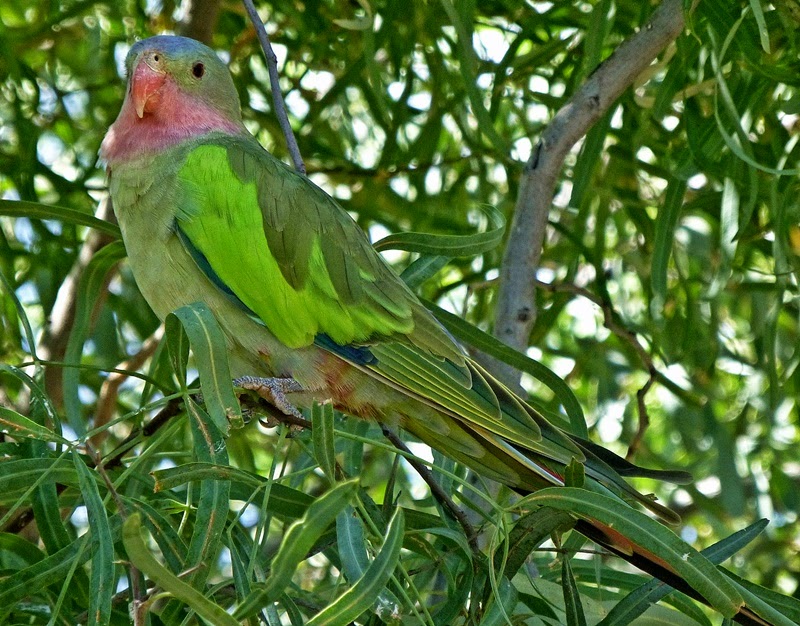We boarded the “fabled” Ghan after breakfast for the
overnight trip from Darwin To Alice Springs.
This train is a sister of the Indian-Pacific which we had
taken from Perth to Adelaide, and we had exactly the same room in an identical
car that we had on that trip. We had
bought an upgrade, and had a roomy cabin:


Note the pull-down bed above the bed you can see. The upgrade promised a bigger lower bed, and
it was—it was about six inches wider than one of our twin beds. We tried to share this, but each of us had as
much width as a baby has in a crib, so we gave up. I took the upper two of the three nights and
Joyce did for one. The food on the train
was absolutely wonderful with choices of innovative meals. For one meal I had kangaroo steaks with a
ground crocodile patty. The Kangaroo is
very tasty, much like venison—lean and gamy.
The crocodile was bland. All
alcoholic drinks are free on the train which led to animated conversations, and
dinner seating is with random people so we met interesting folks. The rails are not smooth and there’s a good
bit of lurching and rocking and the cars creak and groan considerably. Sleep was not ordinary.
The train stopped in the tiny town of Katherine where we had
an excursion to Nitmiluk Mational Park where the Katherine River has formed a
series of beautiful gorges. We went out
on an aluminum boat in 100-degree heat (with a marginally effective canopy) and
cruised the first gorge:
The scenery was truly beautiful. We then did a fairly vigorous walk to the
second gorge where we had another boat trip.
We reversed the process and arrived back at the train as limp as
spaghetti and drenched with sweat as the humidity is high and the sweat doesn’t
evaporate. We’re carrying lots of water
and drinking all the time. It was
beautiful to see, but not easy. Dinner and overnight, then, on the train.
Thursday morning we disembarked at Alice Springs where the
temperature first thing in the morning was in the mid-70’s and the humidity
absolutely dry. Gorgeous! We went to ANZAC Hill, a war memorial on the
top of a tall hill, and had an overview of the town, its history and its
people. It does have a colorful and
interesting story, its founding revolving around the telegraph and connecting
Australia with England via Java. The
current population is 28,000 and includes two US installations, one somewhat
secret with 1000 Americans, run by the CIA, and having to do with satellite
communications, and the other a joint US-Australian seismic monitoring
facility. Here’s a view of the city and
the countryside surrounding it:
We then went to a phenomenal school, the School of the Air,
which runs interactive school programs for children who are isolated on remote “stations”
or what we would call ranches.
Central
Australia is huge and the land so difficult, that the acreage per animal is
large and thus the ranches are far-flung.
We learned about how the system works for these children and watched a
kindergarten class in progress with each child in front of a computer and a
video camera. They do develop a sense of
community, and three times a year all the children come to Alice Springs to
meet each other and to have some more ordinary interactions with other children
and with their teachers. Quite extraordinary.
After lunch we had a 90-minute lecture and slide show on the
culture, art and heritage of the Aborigines which was extremely well done. Their societies and their interpersonal
relationships are very complex and we now have a slightly better understanding
of them. With some free time we walked
to town from our hotel (about 15 minutes, and only about 94 degrees) and
visited a couple of fine art galleries which featured the art of Aboriginal
painters. We bought a wonderful piece
which will be mailed to us.
Finally we went to dinner at the local botanical garden
where we had a barbeque and were entertained by a local singer/songwriter who
was very good. After dark we took our
chairs to a field, all the lights were turned off, and the gorgeous sky
revealed itself while an astronomer took us through the summer southern
sky. The end of another very busy day!














































